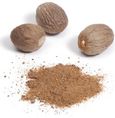Poisonous and / or
Dangerous Foods for Dogs
Part - III -
Are you aware of all the potentially dangerous foods for dogs? Could you be loving your doggie to death ... literally?
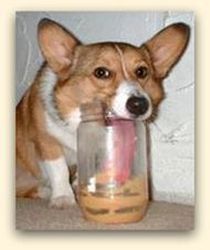
Many dog owners are now becoming aware that chocolate and dogs can be a fatal combination, as can be grapes and dogs, and dogs and onions.
However, fatal dog poisoning can occur after ingestion of many other common foods sitting innocently in your fridge or pantry. And many of these will surprise you!
Our articles on dangerous and/or toxic foods for dogs go in-depth.
Find out exactly why certain foods that are perfectly harmless to us, humans, can lead to life-threatening dog poisoning in your precious pooch.
Learn toxic quantities, and what signs and symptoms your pooch will exhibit if he's had an adverse reaction to any of the following dangerous foods for dogs.
(Note: We are working daily on completing this section. If you would like to be automatically notified as we add new information, please click on the orange RSS button on the left side menu, and subscribe to Dog Food Scoop).
Please note, all the information detailed on our list of poisonous and dangerous foods for dogs, is intended for educational purposes only. This is not a replacement for professional opinion and treatment.
Please contact your Veterinarian or Animal Poison Hotline IMMEDIATELY! Time is critical when dealing with dog poisoning. (Always keep a phone number handy for emergencies) |
DANGEROUS FOODS FOR DOGSTABLE OF CONTENTS |
| Alcohol | Avocados | Baking Soda (Leavening Agents) | Bones - Cooked vs. Raw | Caffeine | Chocolate | Corn on the Cob |
| Fatty Foods | Garlic | Grapes | Hops | Moldy or Spoiled Foods | Mushrooms | Nuts - Macadamias, Almonds, Walnuts |
| Nutmeg | Onions | Pits and Seeds of Fruits | Potato Peelings and Green Potatoes | Raisins | Raw Eggs | Raw Fish |
| Rawhide Dog Bones | Rhubarb | Salt | Sweeteners - Artificial | Tobacco | Tomatoes | Yeast Dough (Raw) |
  Poisonous and / or (Alphabetical Order) | |||||
| HOPS | |||||
If any of you are home brewers, you'll know that hops is a plant used in the making of beer.
Greyhounds appear to be particularly sensitive to hops poisoning, but ALL dogs should be kept away from hops at ALL times. IMPORTANT: Rush your pooch to the vet to induce vomiting and provide after care monitoring. You may find that your vet is unfamiliar with hop toxicity. If necessary, contact an Animal Poison Control Center while at your vet, so they can offer professional advice to your vet. Time is of the essence!SIGNS AND SYMPTOMS Ingestion of hops causes malignant hyperthermia in dogs. Carbon dioxide levels in the blood increase at a dramatic rate, and your dog will run an uncontrollable fever The symptoms of dog poisoning you will likely observe, will be heavy panting and rapid heartbeat (up to 200 beats per minute). Temperatures may rise as quickly as 2 degrees Fahrenheit every five minutes! In some case studies, the dogs' temperatures have reached 108 degrees, at which point death has occurred. HOW MUCH IS TOO MUCH? Even small amounts of hops can trigger a reaction. Greyhounds and Labradors appear to be more susceptible to hop toxicity. Pellet hop ingestion may possibly be slightly less harmful than whole or plug hop ingestion, but all forms can be fatal. WHY ARE HOPS PLANTS POISONOUS FOODS FOR DOGS? Hops plants are extremely dangerous foods for dogs as poisoning occurs leading to malignant hyperthermia. Temperatures rise uncontrollably, and at alarming rates. Carbon dioxide levels in the blood also increase at a dramatic rate. | |||||
| MOLDY OR SPOILED FOODS | |||||
The term used for molds growing on foodstuffs is called mycotoxins. They are potentially found in foods such as dog food, bread, and moldy cheese.
There are a number of different mycotoxins and they are considered dangerous foods for dogs as dogs are highly sensitive and very susceptible to these toxins. The result of dog poisoning by moldy or spoiled foods is impaired liver function. Your pooch may suffer from a short lived, acute attack, or a chronic condition lasting for several days. SIGNS AND SYMPTOMS Early symptoms of dog poisoning by moldy foods you may notice are: Your dog may refuse to eat, vomiting, diarrhea, and abdominal tenderness. This can progress to excessive salivation, muscle tremors, and seizures. Poisoned dogs may also appear to be over sensitive to external noises and activities, etc. HOW MUCH IS TOO MUCH? Dog poisoning can occur after your dog eats as little as one slice of moldy bread. WHY ARE MOLDY FOODS DANGEROUS FOODS FOR DOGS? Dogs are highly sensitive and very susceptible to this toxin. Aflatoxin is metabolized extensively by the liver, and causes severe hepatocellular necrosis, which leads to decreased liver function. The episode can be either acute (short lived), or last from several days to weeks. Penitrem A is a mycotoxin which is produced by Penicillium molds which commonly grow on moldy food items such as nuts, cheese, and bread. It is also commonly found in garbage and compost piles. Penitrem A poisoning in dogs occurs very frequently! Vomitoxin is a less common mycotoxin, which also causes poisoning in dogs. It is produced by the Fusarium mold which grows on grains such as wheat, barley, oats and corn. It is also potentially found in dog food. | |||||
| MUSHROOMS | |||||
Many wild mushrooms are very dangerous foods for dogs, and in the worst cases, can result in the death of your pooch within three to seven days of ingestion. Most cases of mushroom poisoning in dogs in North America occur in the spring, summer, and fall. Many other wild-growing mushrooms are toxic to dogs in varying degrees. Please consider ALL wild mushrooms as toxic, until identified and proven otherwise! If your dog has eaten mushrooms, it is important but often difficult to identify the species of mushroom. Call a Human Poison Information Center, or take a sample of the mushroom with you to your vet for identification. Note: Do not store the mushrooms in a plastic bag. Use a paper bag, moist paper towel, or wax paper. Note: Common white mushrooms appear to be safe and are not considered dangerous foods for dogs. SIGNS AND SYMPTOMS The first symptoms of dog poisoning by Amanita Phalloides mushrooms are: Profuse bloody diarrhea, nausea and vomiting, abdominal pain, dehydration, fever, and a rapid heart beat. This phase typically lasts about 24 hours. The final and, often terminal, phase of poisoning occurs three to four days after eating the mushrooms. The dog will suffer from severe kidney failure, as well as other critical damage and may lapse into a coma. Typically, affected dogs die within three to seven days of ingestion. Dog poisoning by other varieties of wild mushrooms may vary considerably depending on the type of mushroom. You may notice your dog exhibiting any of the following wide range of symptoms: Anxiety, restlessness, excitation, seizures, slow heart beat, wheezing, abdominal pain, visual disturbance, diarrhea, urination, salivation, etc. HOW MUCH IS TOO MUCH? Exact quantities are unknown. Don't take any chances! Get your pooch to the vet immediately. WHY ARE MUSHROOMS DANGEROUS FOODS FOR DOGS? Different mushrooms contain different toxins that typically attack the dog's central nervous system or GI system. For the most part, the toxic components are unknown. Surprisingly, many different types of nuts are generally considered dangerous foods for dogs. Macadamia nuts in particular - (raw, roasted, and macadamia butter) are a known toxic food for dogs and can cause locomotory difficulties. Other varieties of nuts can cause various other dog illnesses and dog poisoning. Nuts generally have a high phosphorus content which causes the formation of bladder stones in dogs. Walnuts can cause gastroenteritis in dogs. Note: Peanuts and peanut butter are generally considered safe foods for dogs. Peanut butter is widely used in dog treats, as a kong stuffer, etc. However, peanut butter is somewhat controversial in that it is also known to contain mold which often leads to yeast growth in pets, as well as in humans. This, in turn, often causes dog skin allergies. SIGNS AND SYMPTOMS The symptoms of bladder stones in dogs you may observe are: straining to urinate, or frequent "dribbling" urination, blood in the urine, and painful urination. The symptoms of dogs eating macadamia nuts are known as locomotory difficulties. Dogs develop elevated body temperature, rapid heartbeat, anxiety, muscle tremors, and weakness or paralysis of the dog's hindquarters (this typically lasts for a few days). They may be unable to stand up, are panting heavily, and show obvious signs of distress. Some dogs develop swollen and painful limbs. The symptoms of gastroenteritis in dogs usually present as persistent vomiting (sometimes bile may be seen in the vomit), dehydration and watery diarrhea. Other symptoms include lethargy, lack of appetite, stomach grumbling, and general listlessness. HOW MUCH IS TOO MUCH? As few as six macadamia nuts can trigger locomotory difficulties in dogs. For other varieties of nuts, it's likely based on how sensitive your pooch's system is, the size of your pooch and, naturally, the more your doggie consumes, the more likely he is to encounter problems. WHY ARE NUTS POISONOUS FOODS FOR DOGS? The toxin in macadamia nuts that causes dog poisoning is not known. Other varieties of nuts are commonly contaminated with very low levels of the poison Aflatoxin which dogs are extremely sensitive to. The high phosphorus content in many nuts can result in bladder stones in dogs. | |||||
The common spice, Nutmeg, is another surprisingly dangerous food for dogs.
Nutmeg causes damage to the dog’s central nervous system and, if ingested in large doses and left untreated, dog poisoning from nutmeg can be fatal. SIGNS AND SYMPTOMS Symptoms you may notice of nutmeg poisoning in dogs are tremors, muscle spasms and seizures. HOW MUCH IS TOO MUCH? Exact quantities are unknown, but it is generally accepted that it would take your dog eating a fairly large quantity of nutmeg to cause death. Remember to take into account your dog's size and that for unknown reasons, certain pooches are more sensitive to certain toxins than others. WHY IS NUTMEG A POISONOUS FOOD FOR DOGS Like many other dangerous foods for dogs, the toxic compound in nutmeg remains unknown, and it is not understood why it is such a poisonous food for dogs. | The pits, seeds, stems and leaves of fruits such as apples, peaches, plums, apricots, persimmons and cherries are considered dangerous foods for dogs, and can cause fatalities.  SIGNS AND SYMPTOMS Signs of cyanide toxicity you will observe in your dog include dilated pupils, apprehension, difficulty breathing, hyperventilation, and shock. Persimmon seeds can cause inflammation of the dog's intestine causing enteritis. In this case, your dog will have diarrhea and possibly a higher temperature. Additionally, pits and seeds can cause intestinal obstruction. Signs of intestinal obstruction may include anorexia, vomiting, diarrhea, abdominal pain, lethargy, no appetite, swollen abdomen, fever, dehydration, and shock. Without treatment, death can occur within 3-4 days. HOW MUCH IS TOO MUCH? It has not been established exactly how many seeds or pits a dog would need to eat before showing symptoms of cyanide poisoning. As always, a smaller dog will likely have a worse reaction to the same amount of seeds, than will a larger breed. However, some dogs may inherently be more sensitive than others.In the case of intestinal obstruction, one pit is enough to cause your dog problems. WHY ARE FRUIT SEEDS AND PITS DANGEROUS FOODS FOR DOGS? Fruit pits, seeds, stems and leaves contain a cyanide type of compound which is toxic to dogs and humans alike. Persimmon seeds can cause inflammation of the dog's intestines. Fruit pits and seeds can cause intestinal obstruction. POTATO PEELINGS AND GREEN POTATOES | | |||
If you notice we have omitted any poisonous or dangerous foods for dogs from our list, please give us a yelp, so we can ensure we have the most comprehensive list available.
You are here: Home > Toxic Foods for Dogs - Introduction > Dangerous Foods For Dogs

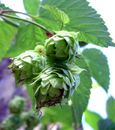
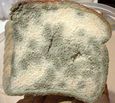
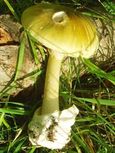 The biggest culprit is the wild mushroom, "Amanita Phalloides", the death cap mushroom, (picture shown), which accounts for the majority of fatal cases of dog poisoning by mushrooms.
The biggest culprit is the wild mushroom, "Amanita Phalloides", the death cap mushroom, (picture shown), which accounts for the majority of fatal cases of dog poisoning by mushrooms.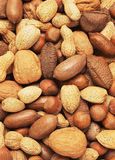 Tree nuts, such as walnuts, pecans, pistachios, and Brazil nuts, are often contaminated with very low levels of the poison Aflatoxin, which comes from the Aspergillus mold. These levels are considered safe for human consumption by the FDA. However,
Tree nuts, such as walnuts, pecans, pistachios, and Brazil nuts, are often contaminated with very low levels of the poison Aflatoxin, which comes from the Aspergillus mold. These levels are considered safe for human consumption by the FDA. However, 